
Out of all the stars dubbed Box Office Poison by the Independent Theater Owners Association in 1938, Edward Arnold probably has the least name recognition among people who aren’t well-versed in classic Hollywood films. But his career was remarkably prolific, spanning nearly 50 years and included work in film, live theater, television, and radio.
After starting his career on the stage in 1907, he spent some time doing films at Essanay Studios for a few years, but returned to the stage and didn’t start focusing on films again until 1932. In the September 1935 issue of Screenland magazine, Arnold says of his early film career, “Pictures intrigued me several years ago, but when I found I’d have to come to Hollywood to show producers I was an actor, I decided to continue on the stage…Then along came my role of the polite murderer with Ernest Truex in ‘Whistling in the Dark,’ which eventually brought us to the Los Angeles Belasco Theater. The morning after the opening, the phones began ringing with screen offers — and I’ve been here ever since.”
That production of Whistling in the Dark opened on January 19, 1932 at the Ethel Barrymore Theater in New York and also featured a then up-and-coming Claire Trevor. After getting back into films, Arnold appeared in several classics of the pre-Code era, including Three On a Match, Hide-Out, Sadie McKee, and I’m No Angel. In I’m No Angel, he starred alongside Mae West, who would later join him on the Box Office Poison list in 1938. Of course, there was also a film adaptation of Whistling in the Dark, which gave him a chance to reprise his role from the stage version.
Even though he’d had a successful stage career, he didn’t immediately become a top-tier movie star. Throughout the early 1930s, if his name made it onto the poster at all, he was often billed below actors like Franchot Tone, Robert Montgomery, and Cary Grant, but he built a good reputation as a character actor. It wasn’t until about 1935 that he started consistently getting top billing. Once he did become a top-billed star, it was sometimes in movies that have since become better remembered for starring other people. 1936’s Come and Get It, for example, is now usually talked about in relation to Frances Farmer. Or in the case of 1937’s Easy Living, he shared top billing with Jean Arthur. But whenever I hear people talk about that movie, it’s usually about Jean Arthur. So was he really that unsuccessful as a leading man?
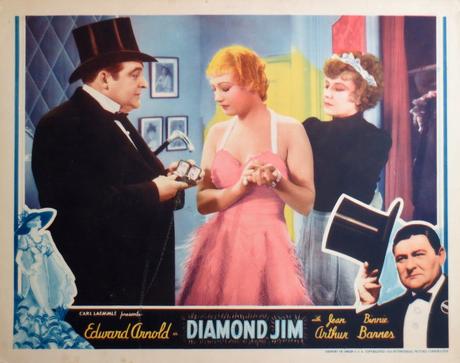
1935’s Diamond Jim was a big opportunity for Edward Arnold to go from character actor to main star. Diamond Jim was released by Universal, who was fighting hard to compete with bigger studios like MGM and Warner Brothers at the time. They had hoped that this tale of the famed businessman would bring them the recognition they wanted. I was not able to find an exact figure for how much money Diamond Jim earned at the box office, but it didn’t earn any award nominations at least. But regardless of whether or not it was a box office smash, it wasn’t necessarily a failure for Edward Arnold. He was memorable enough in the movie to later play Diamond Jim Brady again in 1940’s Lillian Russell and The Motion Picture Herald published comments from theater owners who reported that Diamond Jim did well at their theaters.
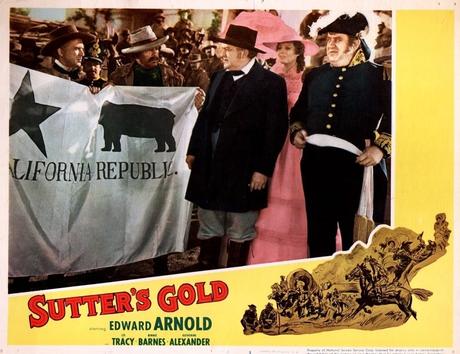
1936’s Sutter’s Gold had a lot of potential, both for Edward Arnold and for Universal Studios, but production was rather difficult. Universal had initially wanted to make Sutter’s Gold in 1928, but the project ended up being shelved for various reasons. Once they were able to move forward with it, it ended up being very costly. City of Dreams: The Making and Remaking of Universal Pictures by Bernard F. Dick described it as a “financial nightmare” for the studio. In addition to the salary for Edward Arnold, which was three times more than he was paid for Diamond Jim, the studio spent a substantial amount of money on having Howard Hawks, William Faulkner, and Gene Fowler work on the screenplay, even though none of them received screen credit. In addition to James Cruze as director, Howard Hawks was also involved with direction in a limited capacity.
Once again, I was unable to find specific figures for Sutter’s Gold‘s box office performance from a reliable source, but many critics and theater owners were not impressed with it. One of the kinder reviews I found was in the April 1936 issue of the National Board of Review Magazine, which said, “Though the story is thrilling and exciting in parts, it is on the whole confusing.” Some comments from theater owners published in issues of the Motion Picture Herald had kind things to say about performances in the movie, but noted that their customers just weren’t interested. The September 12, 1936 issue included a quote from a theater owner in Ipswitch, South Dakota who simply said, “We wasted a good playdate when we booked this one.” A review in the Independent Exhibitor Film Bulletin from April 1, 1936 was positively scathing and basically called it Box Office Poison.
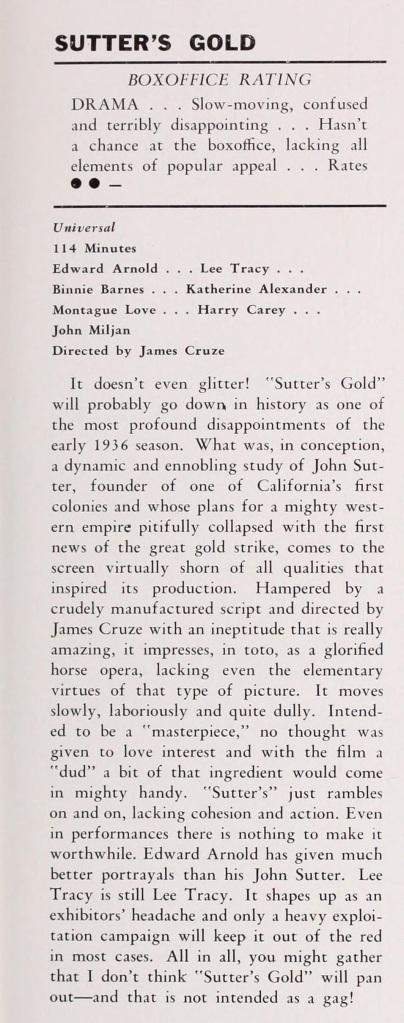
Edward Arnold’s next movie after Sutter’s Gold was 1936’s Meet Nero Wolf. Meet Nero Wolf wasn’t a runaway success, but at least the critical reception was more of a mixed bag than Sutter’s Gold. A selection of reviews published in Motion Picture Review Digest include a good amount of positive notes, several that were middling, and only one that was outright negative. Overall, many noted that it wasn’t as strong as other detective movies like the Philo Vance movies, but was still enjoyable enough for light summer entertainment. Edward Arnold’s performance was well received and even the lone negative review even noted that he deserved better material. (“The first and we hope last in a projected series…We hope that Mr. Arnold, Stander and Herbert Biberman [the latter directed the film] will be spared connection with the next in the series.” -Robert Stebbins, New Theater)
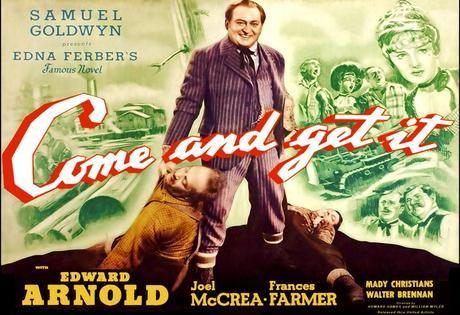
1936’s Come and get It was unquestionably a critical darling. Motion Picture Review Digest published nearly two pages of reviews that were overwhelmingly positive, with many that could safely be described as “raves,” from both mainstream magazines/newspapers and trade publications. There were lots of good reviews for its direction and photography. Since Come and Get It was produced by Samuel Goldwyn, many kind things were said about his taste in projects and called it a worthy follow-up to Dodsworth. Frances Farmer and Walter Brennan received good notes and many praised Edward Arnold for giving one of the best performances of his career. But despite all the acclaim, the only person to win an Oscar for Come and Get It was Walter Brennan, who has the distinction of winning the first Best Supporting Actor Academy Award for his performance. It’s also difficult to tell how successful it was financially. I was unable to find any specific figures, but “William Wyler: The Life and Films of Hollywood’s Most Celebrated Director” by Gabriel Miller notes that Come and Get It outperformed Dodsworth at the box office.
1937 was an interesting year for Edward Arnold’s career because he had two major movies released within the same month: Easy Living with Jean Arthur and Ray Milland and The Toast of New York with Cary Grant and Frances Farmer.

Of the two movies, Easy Living was the first one released. Initial reviews for Easy Living weren’t quite raves, but still positive overall. Generally, a lot of critics thought it was nonsense, but fun and entertaining nonsense. Variety‘s review was the most critical of the ones I found:
“This one is a poor imitation lacking the spontaneity and cleverness of My Man Godfrey…It is likely to open big and then fall off when customers are asked what they think about it. Disconcerting is the fact that the studio spared neither expense nor talent in its efforts to make something good out of something that was middle-class when it started.”
While I’m (once again) unable to find any actual figures to prove whether or not Variety was accurate in its predictions for Easy Living‘s box office performance, Paramount ran an ad in the Motion Picture Herald touting its successful run in New York during a heat wave.
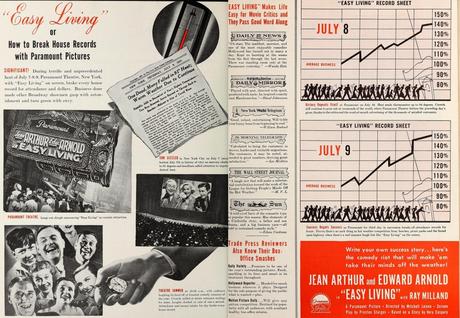
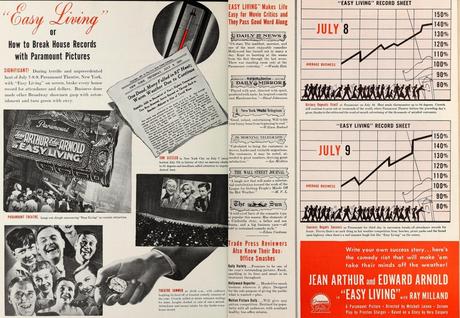
It’s also worth noting that Edward Arnold’s performances were often singled out in reviews up until this point, even when the movie itself was otherwise panned. But Jean Arthur got a lot more of the attention for Easy Living. In the Independent Exhibitors Film Bulletin, theater owners were even specifically advised to feature Jean Arthur when promoting the movie, even though they called Edward Arnold’s performance “delightful.”
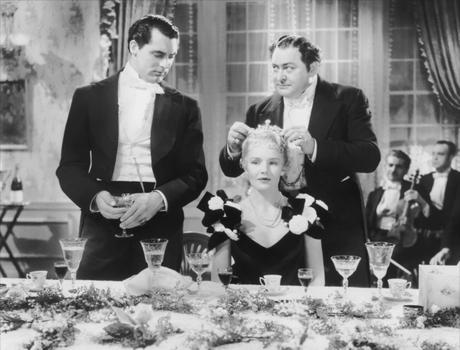
The fact that Easy Living and The Toast of New York were released in the same month means I was able to find reviews of The Toast of the Town right alongside reviews of Easy Living. It’s interesting to see these initial reviews juxtaposed knowing the respective reputations the movies have over 80 years later. It’s a great example of how, sometimes, early critical opinions aren’t a reliable way to tell whether or not a movie will be successful with audiences, either in the short term or years down the line. In the case of Easy Living, it’s now regarded as a screwball comedy classic, so perhaps some of the initial reviews underestimated it just slightly. The exact opposite ended up happening with The Toast of New York.
“One of the most entertaining wonderworks of the year, without a dull spot in its several thousand feet of film.” “It is screen entertainment of the highest order.” “Contains more than the usual quota of of entertainment for the classes.” “This is an important comedy drama of an important period in American history. It has been brilliantly acted and directed, and with the names of Edward Arnold, Cary Grant, Jack Oakie, and Frances Farmer decorating the marquee, it should play to heavy box office returns.” These are all excerpts from initial reviews of The Toast of New York, mostly from trade publications, which set the bar too high. The Toast of New York was reportedly RKO’s biggest financial loss of the year, losing a total of $530,000. It doesn’t seem that The Toast of New York had the benefit of a big critical re-evaluation over the years, either. As of December 2021, it only has 6.3 stars on IMDB.
With how little specific information I was able to find about the box office performance of Edward Arnold’s movies, it’s difficult for me to tell whether or not his box office appeal was really dwindling by the time the Box Office Poison ad was published in 1938. It certainly seems that he had his ups and downs, like many performers do. In any case, it seems that Blossoms on Broadway, also released in 1937, it was a something of a breaking point. Issues of the Motion Picture Herald published in January 1938 feature some comments from theater owners who seemed positively exasperated by the movie:
“After 25 years, Adolph Zukor still makes 85 percent of his product B-C and D pictures. Will he ever find out that exhibitors want good pictures and not stuff like this one. His 1937-38 product, outside of 2 pictures up to this time, has been terrible. They drive business away. Make good ones or none at all.”
“Poorest Paramount we have taken from a can in three years. Shame to use such stars in so worthless and crude a thing as this.”
“A million dollars worth of talent wasted on this bit of disconnected and poorly constructed story. Don’t play it.”
“Good cast but plot unworthy. Very poor entertainment.”
Edward Arnold’s first movie released after the Box Office Poison ad was published in 1938 was The Crowd Roars. But this time around, he was playing a supporting role with Robert Taylor as the top-billed lead. From then on, he’d remain a supporting actor, gladly embracing smaller, richer character parts rather than main leads. The transition proved to be a good move and he finished out the 1930s with supporting roles in two of the most beloved movies of the decade: You Can’t Take it With You and Mr. Smith Goes to Washington.
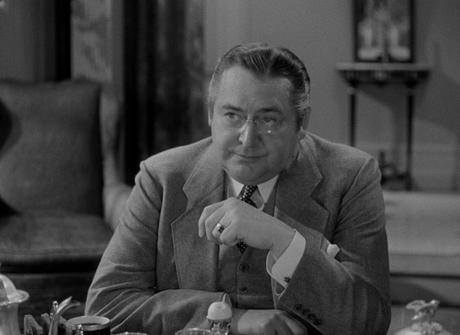
In many cases, the idea of losing that coveted “leading man/leading lady” status would be enough to make a movie star panic, unless they were already looking to retire. But out of all the stars named Box Office Poison, Edward Arnold was perhaps the one least attached to the idea being a lead and always viewed character roles as having more to offer.
Looking back at articles about him which were published in the time leading up to the release of Diamond Jim, it’s interesting to note that he liked to sing the praises of being a character actor rather than talk about his new status as leading man like you’d expect many stars would want to. In the September 1935 issue of Screenland, he talks about himself in terms of being a character actor rather than a leading man.
“Of course, a character actor has much more liberty than a romantic leading man, for we don’t have to bother with camera angles or worry about the curl of our hair or which side of our face looks the best. All we have to do is cut loose and visualize our characters into being.”
In Photoplay magazine’s July 1935 issue, an article about him starring in Diamond Jim gave him a chance to talk about his desire to play a wide range of roles and how not being the lead can help in that respect.
“Coming to Hollywood three and a half years ago, I was darn near typed in pictures after playing gangsters in Okay, America and Whistling in the Dark. I got away from parts of that kind just in time. There’s a wide variety in other character roles. What’s more, movie audiences help you. People always know what’s going to happen to the lead — that no matter what he goes through he will in the end get the girl — but they never know what will happen to the character man — whether he’ll turn out to be a drunk, kill himself, or be hanged.”
The author of that article notes that, “these possibilities seemed to fill Mr. Arnold with a deep contentment as he leaned back and sighed restfully.” The article ends with Edward Arnold being quoted as saying, “And I thank God I’m a character actor!”
With an outlook like that, it’s no wonder he remained in high demand as a character actor for decades afterward, appearing in classics like Meet John Doe, The Devil and Daniel Webster, and Annie Get Your Gun. In addition to his film career, he was active in radio and television before his death in 1956.
